
Benefits of Starting the Day with Stretching
Stretching is a common pre-activity routine which typically consists of holding an elongated muscle at its maximal stretch length for a period of time, usually 30 – 60 seconds. More and more research is surfacing evaluating different types of stretching and its effects on performance, mobility and functionality.
Static vs Dynamic Stretching
Static stretching involves moving a joint as far as the muscle will allow until you feel a comfortable pull, holding the position for 30 - 60 seconds.
Dynamic stretching is repetitively moving joints and muscles with sports-specific motions for approximately 10 - 12 repetitions targeting certain groups of muscles.
There has been a shift in popularity towards dynamic stretching for warm-ups as recent research reveals that a single bout of static stretching reduces maximal strength, power, and performance prior to sport. [1] However, those who simply want to increase or maintain range of motion for everyday living can incorporate both static and dynamic stretching into their daily routine.
Benefits of Stretching
The benefits of incorporating stretching into your daily routine are infinite, with research showing that it may have a positive impact on both your physical and mental wellbeing. Benefits include:
- Increased range of movement of the joints [2]
If you find that you are not able to move a joint through its full range of motion it may be contributed to tightness of capsular ligaments, muscles and tendons. Typically when we stretch we are targeting certain muscle groups, however it is important to note that all other soft tissues in the area are also being stretched. This allows for greater flexibility in all of the soft tissues surrounding the joints helping you achieve full range of motion and greater freedom of movement. - Increased flexibility
Improved flexibility may help you in completing every day activities with relative ease and is considered important in maintaining health and wellbeing. Research also suggests that increased flexibility may aid in delaying reduced mobility associated with aging. - Improves performance in physical activity
Dynamic stretching has been found to increase joint range of motion and enhance muscle power prior to physical activity. [3] - Reduces delayed onset muscle soreness (DOMS) post physical activity
Following intense physical activity, microscopic tears can form in your muscles leading to increased inflammation in the area. Studies suggest that stretching can increase blood flow to the muscle which can help to decrease this inflammation, reducing delayed onset muscle soreness. [4] - Improved posture and reduced spinal pain
A common cause of spinal pain is musculature imbalance in which weak muscles are opposed by very tight muscles. Stretching those tight muscles with accompanied strengthening of opposing muscles can help to restore musculature imbalances and may reduce the intensity and recurrence of spinal pain. - Increased balance and mobility
Musculature imbalance also has the potential to disrupt normal movement patterns and challenge stability. Therefore restoring muscular imbalances through stretching and strengthening may aid in increased balance and mobility. - Improved mental health
It is well known that emotional stress can manifest physically in the form of tightness and tension in the muscles. Focus on stretching the areas that commonly hold stress – the neck, shoulders and upper back. Focus on mindfulness and meditation while stretching to give yourself a mental break. - Reduces intensity and frequency of headaches
Any muscle of the head or neck has the ability to cause headaches. If your chiropractor has identified problem muscles, stretching them may improve your headaches. It is also important to maintain a healthy diet, drink plenty of water and exercise regularly to help improve tension headaches.
So How Do I Start?
Dynamic Stretches
Dynamic stretching can be completed before sports or athletics, weightlifting and cardiovascular exercise and should incorporate movements and major muscle groups involved in the activity. It is generally recommended that you complete 10 – 12 repetitions of the sport-specific motion.
Below are some examples of simple dynamic stretches you may choose to incorporate into your warm-ups and can also be included in your every-day stretching routine.
Hip Circles
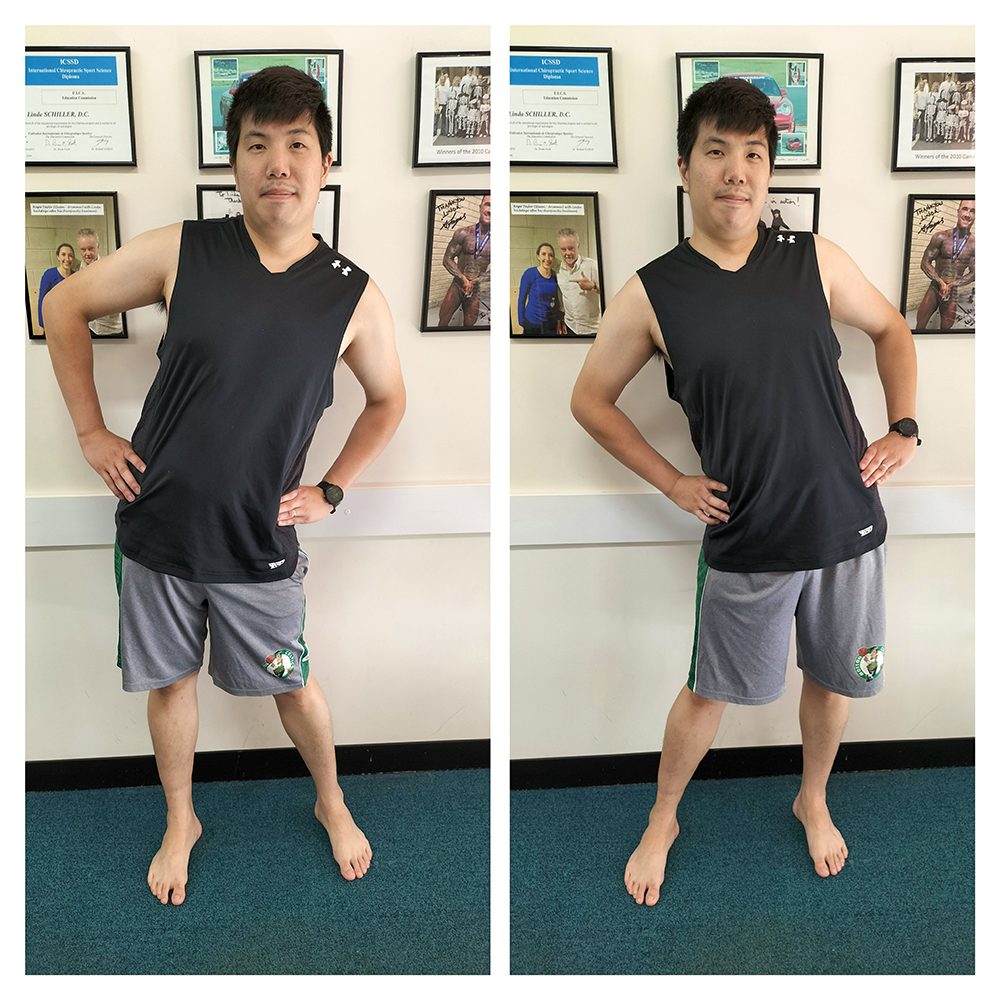
Arm Circles
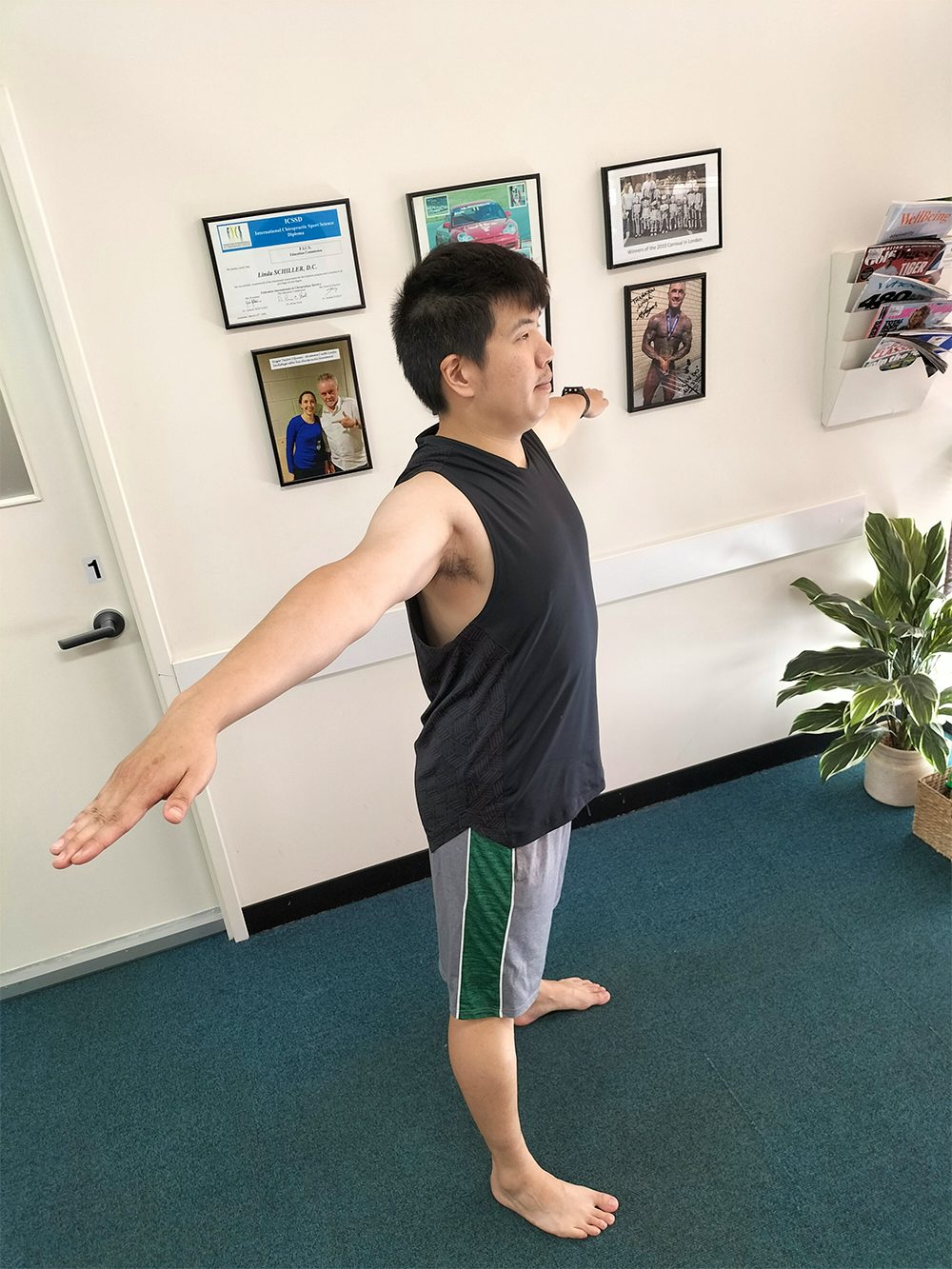
Spinal Rotations
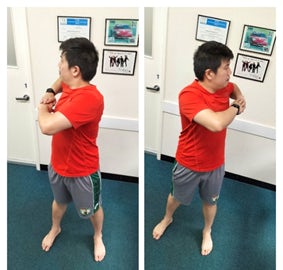
Leg Pendulum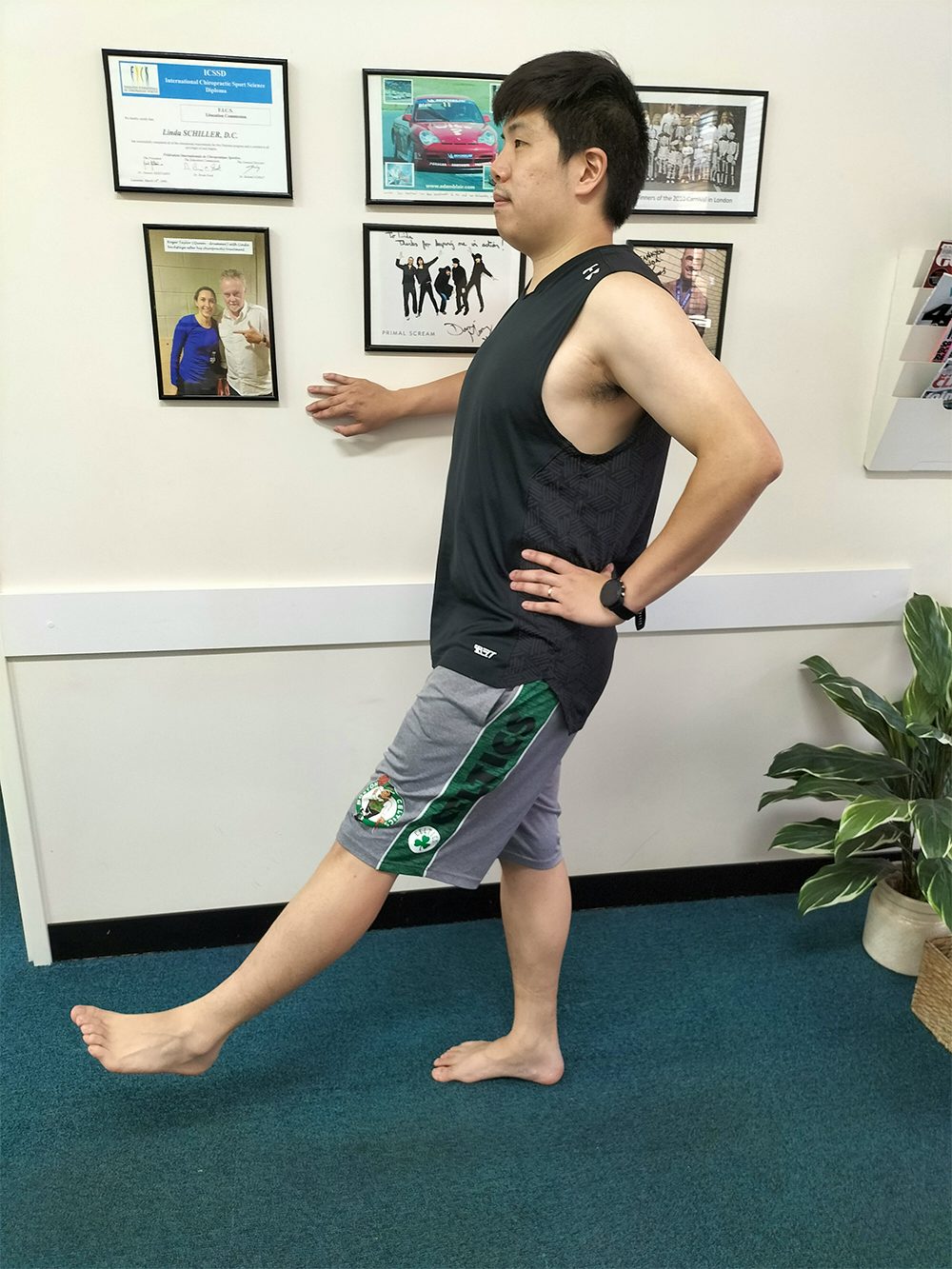
- Hip Circles
• Stand on one leg and hold onto a wall for support
• Gently swing your other leg in circles out to the side. Start with small circles and gradually work up to larger circles as you become more flexible.
• Complete 10 – 12 repetitions and repeat on the other side. - Arm Circles
• Stand with your feet shoulder width apart and both arms out by your side at shoulder height.
• Gently circle your arms slowly working up from small circles into bigger circles.
• Complete 10 -12 repetitions and repeat in the opposite circular direction. - Spinal Rotations
• Stand with your feet shoulder width apart with your arms out in front of you at shoulder height.
• Keep your torso still and gently rotate your body from left to right.
• Complete 10 – 12 repetitions. - Leg Pendulum
• Hold onto a wall for balance and starting swinging one leg back and forth.
• Complete 10 – 12 repetitions before switching sides and completing the stretch using your other leg.
• You may also choose to face the wall and complete a similar stretch swinging your leg from side-to-side.
Static Stretches
A daily stretching routine may be beneficial, however if you are new to regular stretching it is important to take it slowly. Start with stretching 5 – 10 minutes a day at a set time to help you get into a well-developed routine. When stretching, focus on the areas in your body that you feel hold tension. For your lower back and legs, focus on hamstrings, calves, hip flexors, quads and lower back muscles. For you upper back and body relief focus on mid back, neck, shoulders and arms.
Stretch the muscle as far as you can go until you feel a light pull and hold this position for 30 – 60 seconds. If any of these stretches become too painful or you are not able to do them due to pain or inflexibility, speak to your chiropractor and they can alter the stretch to your capabilities. If the pain becomes unbearable, slowly ease out of the stretch and stop immediately. It is important to hold the stretch and avoid bouncing movements.
Below is a 5 minute stretching routine that you can use to help get you started.
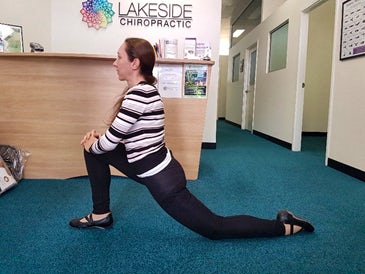
Runners Stretch
| STRETCH | MUSCLES STRETCHED | BENEFIT | HOW TO |
|---|---|---|---|
| Runner’s Stretch | hamstrings, hip flexors, low back, calves | Tight hamstrings and hip flexors are often involved in musculatures imbalances contributing to poor low back posture and pain. | Stand with your feet hip-width apart. Step back with your left leg and place both of your hands on the ground on either side of your right foot, about shoulder-width apart. Your left knee should be on the ground. Lower your hips until you feel a stretch in the front of your left hip and leg. Hold for 30 seconds. Slowly straighten your front leg, keeping your hands planted on the floor. Don’t worry if you can’t get your leg completely straight. Hold for 30 seconds. Repeat on the other side. |
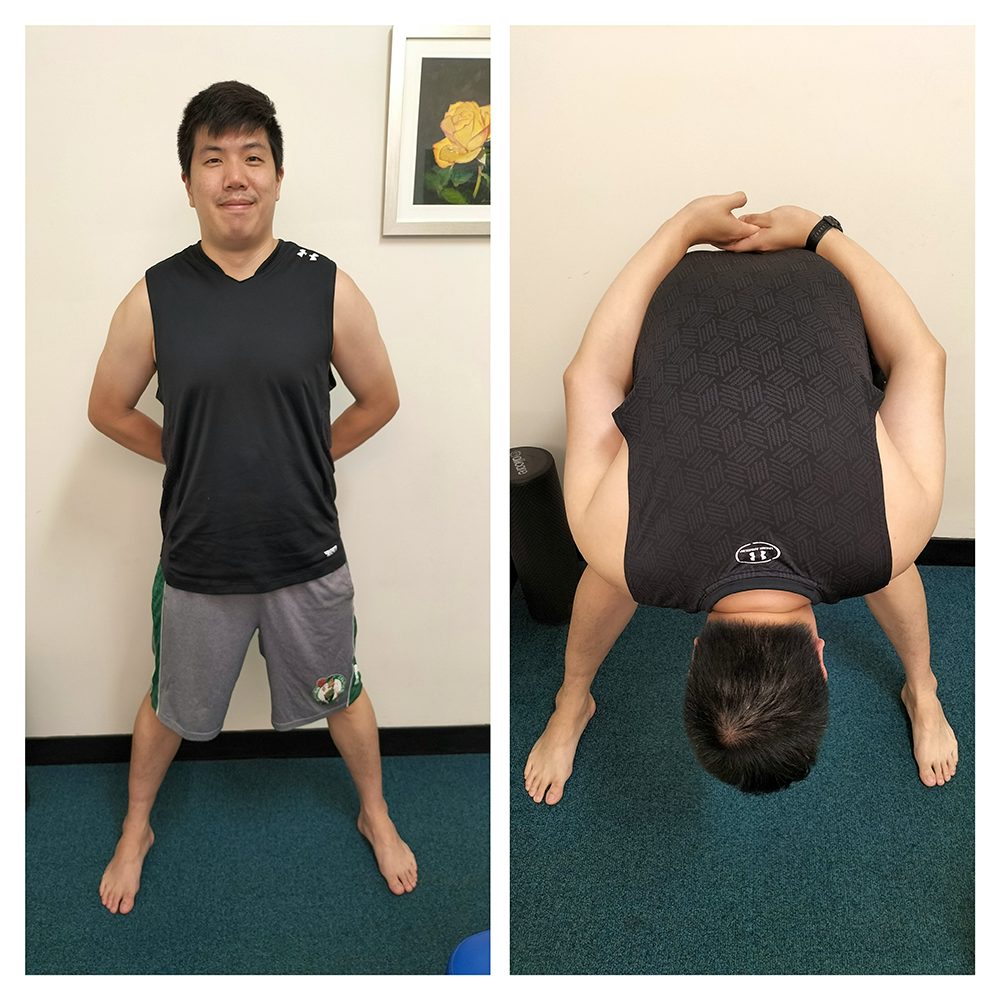
Forward Fold
| STRETCH | MUSCLES STRETCHED | BENEFIT | HOW TO |
|---|---|---|---|
| Forward Fold | hamstrings, shoulders, low back, chest | This is a great full body stretch which may help relieve low back pain and open up the shoulders and chest, making it an ideal stretch for people with jobs that are associated with long periods of sitting. | Stand with your feet hip-width apart, toes pointing forward. Reach your hands behind you to meet behind your glutes. Interlace your fingers, if possible. Keeping a flat back, bend at the waist, shifting your hips backward and weight in your heels until you feel a stretch down the back of your legs. As you bend forward, let gravity pull your arms above your head, keeping your arms straight. Only go as far as your shoulder flexibility will allow. Hold this position for 30 seconds. Repeat. |
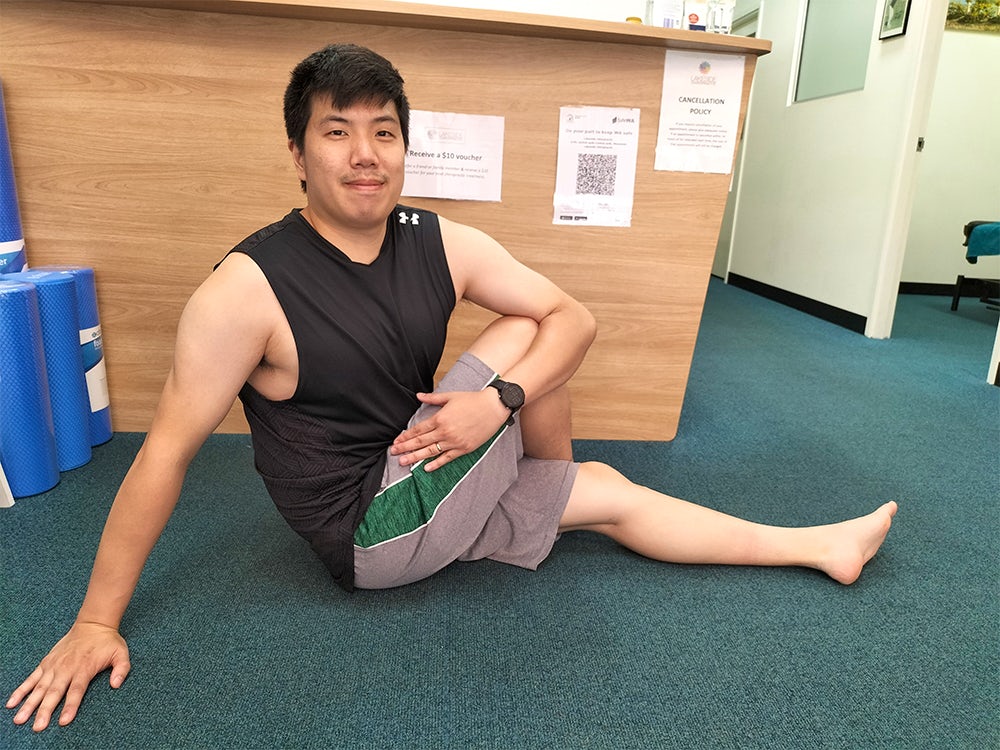
Seated Back Twist
| STRETCH | MUSCLES STRETCHED | BENEFIT | HOW TO |
|---|---|---|---|
| Seated Back Twist | erector spinae, glutes, low back | This stretch is great for relieving back pain and increasing the range of motion in the spine. If twisting motions tend to increase your back pain AVOID this stretch. | Sit on the floor, legs crossed with your left leg on top. Cross your left leg further over your right leg, placing your foot on the ground by your right knee so that your left knee is pointing upward. Gently twist your shoulders toward the left, pushing against your left leg for leverage. Only go as far as comfortable. Hold position for 30 seconds. Repeat on other side. |
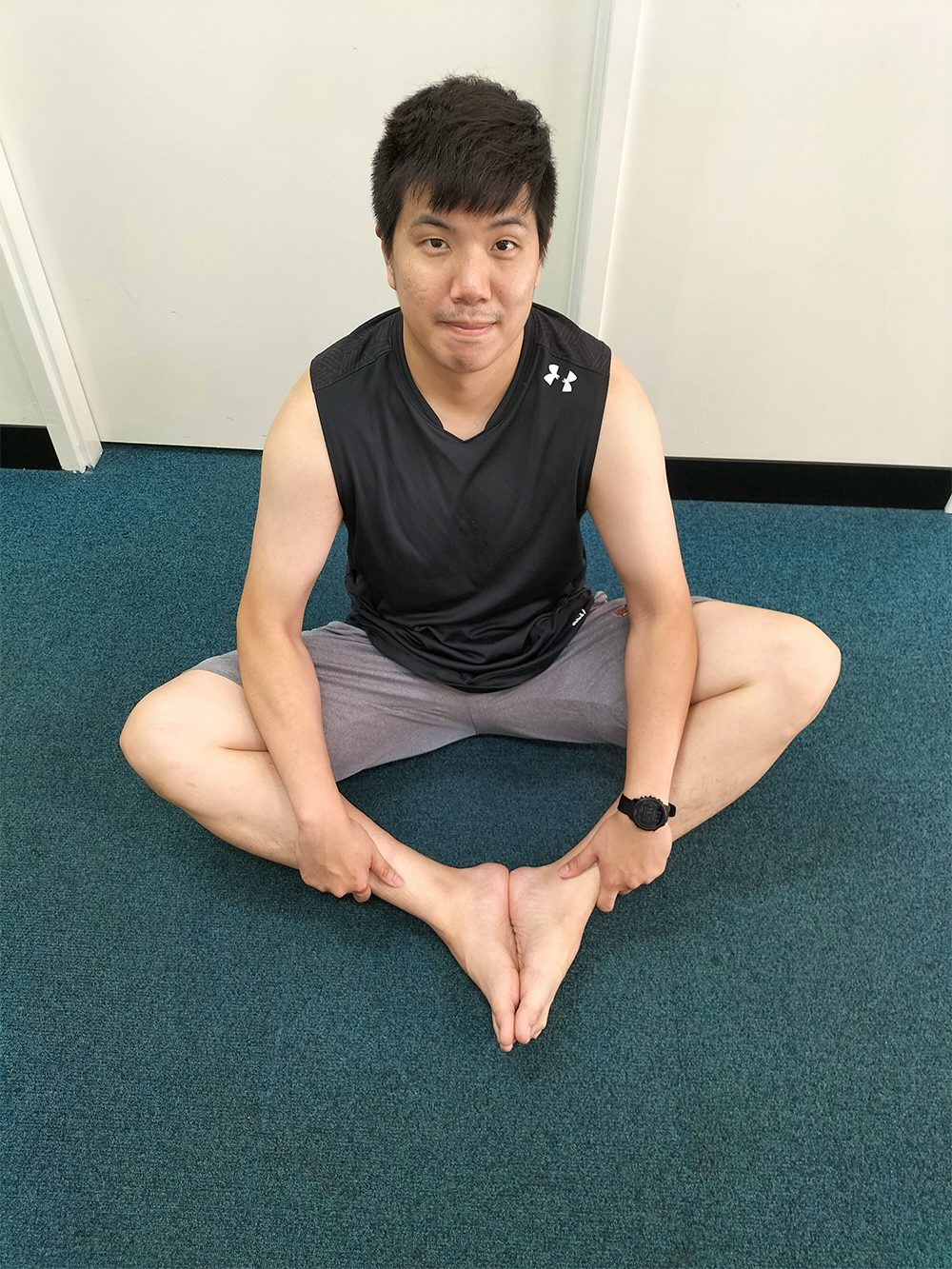
Bound Angle
| STRETCH | MUSCLES STRETCHED | BENEFIT | HOW TO |
|---|---|---|---|
| Bound Angle | adductors, hip flexors, glutes | This stretch is very effective in opening up the hip joints and relieving muscle tightness around the hips, glutes and inside of the thighs. | Sit on the floor, back straight. Keep the soles of the feet touching. Place your hands on your feet and lengthen through the spine. Feel as if there is a string pulling your head to the ceiling and shift your weight forward off your tailbone. Using your arms to assist, lean forward with a flat back, bringing your head toward your feet. Only go as far as comfortable. Hold position for 30 seconds. |
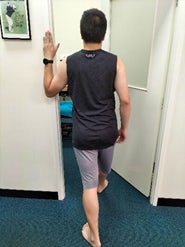
Chest Stretch
| STRETCH | MUSCLES STRETCHED | BENEFIT | HOW TO |
|---|---|---|---|
| Chest Stretch in Door Frame | pecs, anterior deltoid, biceps | These muscles, when tight, often result in poor posture including rounding of the shoulders. Stretching these muscles is important in restoring optimal posture, reducing upper body pain and can improve breathing but opening up the chest. | Stand in the middle of an open door. Place your forearms on each side of the doorframe, if possible. If the doorway is too wide, do one arm at a time. Gently lean forward into the doorway until you feel a stretch through the front of the chest and shoulders. Only go as far as comfortable. Hold position for 30 seconds. |
At Lakeside Chiropractic, our experienced and holistic chiropractors can provide advice and resources to help you establish a daily stretching routine tailored to your specific needs to achieve optimal physical and mental wellbeing. We are a Medibank and BUPA preferred practice but accept all health insurance which you can claim on premises through our HICAPS machine. If you have any enquiries or would like to book an appointment, feel free to contact one of our friendly staff on 9300 0095 or visit our website at www.lakesidechiro.com.au to book an appointment.
References
1. David G. Behm, Anthony J. Blazevich, Anthony D. Kay, and Malachy McHugh. Acute effects of muscle stretching on physical performance, range of motion, and injury incidence in healthy active individuals: a systematic review. Applied Physiology, Nutrition, and Metabolism. 41(1): 1-11. https://doi.org/10.1139/apnm-2015-0235
2. Page P. (2012). Current concepts in muscle stretching for exercise and rehabilitation. International journal of sports physical therapy, 7(1), 109–119.
3. Opplert J, Babault N. Acute Effects of Dynamic Stretching on Muscle Flexibility and Performance: An Analysis of the Current Literature. Sports Med. 2018 Feb;48(2):299-325. doi: 10.1007/s40279-017-0797-9. PMID: 29063454.
4. Hotta K, Behnke BJ, Arjmandi B, Ghosh P, Chen B, Brooks R, Maraj JJ, Elam ML, Maher P, Kurien D, Churchill A, Sepulveda JL, Kabolowsky MB, Christou DD, Muller-Delp JM. Daily muscle stretching enhances blood flow, endothelial function, capillarity, vascular volume and connectivity in aged skeletal muscle. J Physiol. 2018 May 15;596(10):1903-1917. doi: 10.1113/JP275459. Epub 2018 Apr 5. PMID: 29623692; PMCID: PMC5978284.



